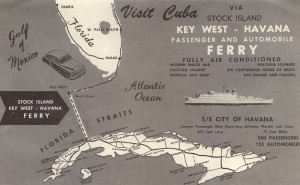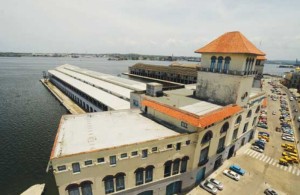KEY WEST-LA HABANA BY RAIL, “HABANA SPECIAL”, A DREAM FRUSTRATED.
Sitting comfortably cross the sea in a railroad car and know that the train goes first on the narrow summit of a mountain of coral and then ride over the waters, it seems fairy thing. Like fairies do not exist, only a man like billionaire Henry Flagler, say experts, was able to a company like that which extended the railroad to Miami and from there, island in island, led to Key West so as to connect with Cuba, the rest of the Caribbean and the Panama Canal.
Goods and passengers out of New York by train and took two days to arrive at Cayo, where a huge ferry service-boats, on a journey of ten hours, carrying freight wagons that would roll later to Santiago de Cuba in the east of the island.
The route is known under the name of The Havana Special and also possible for Cuba take advantage of the new logistics to reassert itself as a major supplier of the US market.
Thanks to this itinerary, thousands of American tourists were arriving, year after year, to the Cuban capital.
For them, Constantine Ribalaigua, Floridita bar owner and king of Cuban bartenders, cocktail created Havana Special, one of the ten largest deals of national cocktail, although less known than the daiquiri, the mulatto, the president and the mojito.
The railroad was undertaken with steel and cement from Germany and Cuban wood. It took seven years of tremendous work. For long periods until 4000 men labored there simultaneously. Three-one cyclone, with 200 dead workers hindered the construction.
Meteors would not be the only drawback. The first of the engineers who took on the project, went wild over the reefs, and that continued and carried out the task, never able to return to work on his own.
Either way, the January 22, 1912, with the arrival of the first train Key West from Miami, Flagler made his dream come true, and that same day shipped to Havana to promote its route over the keys. Twenty years later, on September 2, 1935, a hurricane category five partially destroyed the railway infrastructure.
The owners of The Havana Special which was sold to the state of Florida. On the ruins the road network, since 1938, joins together Floridians keys and links to the mainland was erected.

Trip in Ferries Key West-La Habana that worked for many years until 1959 carry passengers and merchandise.
Since then the ferry-boats not transported railcars. They continued their line passages and general cargo and travelers gave both sides the opportunity to visit the bank counter with his own car.
The ferry from Key West were interrupted after 1959. Today, Havana Special is just the cocktail created by Constantine Ribalaigua, while in the Cayo Flagler bust recalls the story of the famous railway.
CiroBianchiRoss / InternetPhotos / ww.thecubanhistory.com
The Cuban History, Hollywood.
Arnoldo Varona, Editor.
KEY WEST-LA HABANA POR FERROCARRIL, “HABANA SPECIAL”, UN SUEÑO FRUSTRADO.
Cruzar el mar sentado cómodamente en un vagón de ferrocarril y saber que el tren avanza primero sobre la cumbre angosta de una montaña de coral y que cabalgará luego sobre las aguas, parece cosa de hadas. Como las hadas no existen, solo un hombre como el multimillonario Henry Flagler, aseguran especialistas, fue capaz de una empresa como esa que extendió la vía férrea hasta Miami y desde allí, de isleta en isleta, la llevó hasta Cayo Hueso para conectar así con Cuba, el resto del Caribe y el Canal de Panamá.
Mercancías y pasajeros salían de Nueva York en tren y tardaban dos días en arribar al Cayo, donde un servicio de enormes ferry-boats, en una travesía de diez horas, transportaba los vagones ferroviarios que rodarían más tarde hasta Santiago de Cuba, en el oriente de la Isla.
La ruta se conocería con el nombre de The Havana Special y posibilitó que Cuba se aprovechara también de la nueva logística para reafirmarse como un importante suministrador del mercado norteamericano.
Gracias a ese itinerario, miles de turistas norteamericanos arribaban, año tras año, a la capital cubana. Para ellos, Constantino Ribalaigua, propietario del bar Floridita y rey de los cantineros cubanos, creó el coctel Havana Special, una de las diez grandes ofertas de la coctelería nacional, aunque menos conocida que el daiquirí, el mulata, el presidente y el mojito.
El camino de hierro se acometió con acero y cemento de Alemania y maderas cubanas. Requirió siete años de ingente labor. Por largos períodos hasta 4 000 hombres laboraron allí de manera simultánea. Tres ciclones –uno, con 200 trabajadores muertos– entorpecieron la construcción.
No serían los meteoros el único inconveniente. El primero de los ingenieros que asumió el proyecto, enloqueció sobre los arrecifes, y el que prosiguió y llevó a término la tarea, nunca más pudo volver a trabajar en lo suyo.
De cualquier manera, el 22 de enero de 1912, con la llegada a Cayo Hueso del primer tren procedente de Miami, Flagler hacía realidad su sueño, y ese mismo día embarcaba hacia La Habana a fin de promover su ruta sobre los cayos. Veintitrés años después, el 2 de septiembre de 1935, un huracán de categoría cinco destruyó parcialmente la infraestructura ferroviaria.
Los propietarios de The Havana Special vendieron lo que quedó al estado de la Florida. Sobre aquellas ruinas se erigió la red de carreteras que, desde 1938, une entre sí los cayos floridanos y los enlaza con la península.

Trip in Ferries Key West-La Habana that worked for many years until 1959 carry passengers and merchandise.
Desde entonces los ferry-boats no transportaron vagones de ferrocarril. Prosiguieron su línea de pasajes y carga general, y dieron a los viajeros de ambas partes la oportunidad de visitar la orilla contraria con su propio automóvil.
El ferry de Cayo Hueso se interrumpió después de 1959. Hoy, el Havana Special es solo el coctel creado por Constantino Ribalaigua, mientras que en el Cayo un busto de Flagler recuerda la historia de su famoso ferrocarril.
CiroBianchiRoss/InternetPhotos/ww.thecubanhistory.com
The CUban History, Hollywood.
Arnoldo Varona, Editor.





